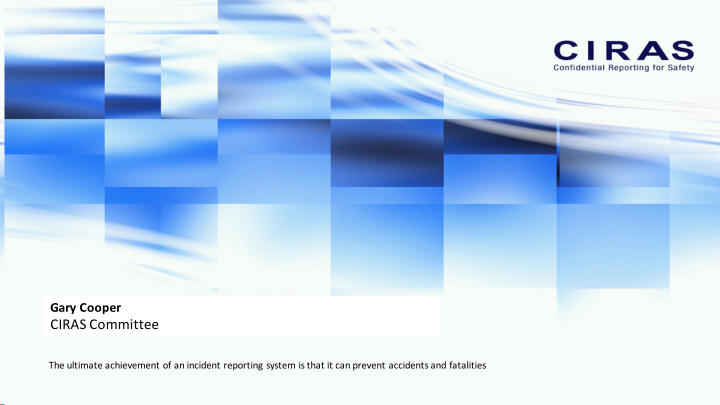



Gary Cooper CIRAS Committee The ultimate achievement of an incident reporting system is that it can prevent accidents and fatalities
Introduction • Joined British Rail in 1984 – first job station supervisor • Operations lead for the response to 1988 Clapham accident • First British Rail accredited Safety Auditor - 1990 • Proposed and delivered the first Strategic Safety Management training for Senior Managers • Worked at Director/Professional Head level across the rail industry in operations, engineering, safety retail, performance and planning • CIRAS committee member since 2009
So why a confidential reporting system? • Enables management action before loss events occur • Provides workers at every level with a confidential outlet for concerns • Provides member organisations data based analysis - opportunities for shared learning and improved safety • Supports members’ business processes and adds value as part of a mature wider safety strategy
How does CIRAS work? • CIRAS listens to any genuine safety or health concern • Trained staff conduct confidential interviews with those who make contact (reporters) • Commitment to confidentiality is absolute • We encourage people to report concerns using internal channels in the first instance, but recognise this is not always possible • Anonymous data on reports is shared with members to improve their business performance
CIRAS – a history • Began as a pilot scheme in Scotland in 1996 • Industry mandate following Ladbroke Grove in 1999 and the subsequent Lord Cullen report • CIRAS operated as a charitable trust between 2001 and 2009 • In 2009 the industry agreed that CIRAS should be hosted by RSSB
CIRAS – the challenges 2009 to 2012 • New committee members recognised CIRAS was underperforming nor well respected • Neither reporters nor subscribers were being served well • Subscribers were Ø not being provided with information Ø stakeholder engagement didn’t exist; Ø subscription formula was chaos Ø alienated from the service
CIRAS – the improvements 2013 to 2016 Formal establishment of independence from RSSB • Ø hosted but not managed Ø ‘consenting adults’ New management structure and lead • Ø Replacement of existing managers Five-year business strategy, and aims and objectives • agreed with funders Commitment to add value to reporters and members •
CIRAS – 2013 to 2016 2014 targeted new members • rail and non-rail Rational transparent • membership fee Greater respect from • businesses served but still more to do…
CIRAS – Growth Now have more than 1,600 paying members compared to 41 in 2012 • 13.5% increase in reports since 2014/15 • For 2016/17, 85% of our members have seen a reduced fee or unchanged • fee Non rail members •
CIRAS – Growth No. of members (2012 - 2016) 1643 1800 1600 1400 1200 1000 800 600 400 133 86 41 200 0 2012/13 2013/14 2014/15 2015/16
CIRAS – the future • Continued commitment to absolute confidentiality for all reporters • Continue to ensure value for money for those who subscribe • Must step up game on analysis to add value to subscribers • Commitment to continued development through strong governance • Reporters’ and members’ needs to be met and, better, exceeded – absolute focus on both groups
Recommend
More recommend